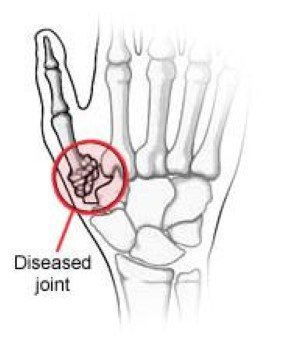Arthritis of the thumb (Carpometacarpal Arthritis)
Carpo- refers to you wrist bones and –metacarpal refers to the long bone between your wrist bones and thumb bones. The joint between these two bones is called the carpometacarpal joint. With age, arthritis may develop at this joint. Thumb arthritis occurs when the cushioning cartilage at the joining ends of these two bones wears away. This may result in pain, swelling, decreased strength and range of motion, making it difficult to do simple activities of daily living. The goal of treatment is to relieve pain and reduce inflammation. Depending on the severity of the arthritis, your doctor may recommend surgery.
Carpometacarpal arthritis affects the joints between the wrist bones and long bones of your fingers. When it involves the joint at the base of the thumb, it is often called basal joint arthritis. The basal joint is the joint made up of the metacarpal of the thumb and the associated carpal bone, the trapezium. This joint is important in enabling the thumb to pivot, swivel and pinch so that you can grip things.
With age and use, arthritis may develop at this joint. Thumb arthritis occurs when the cushioning cartilage at the joining ends of these two bones wears away. The cartilage allows the bones to glide easily in the joint, but without it, the bones rub directly against each other. This in turn causes damage to the bones and joint.
Basal joint arthritis may result in pain, swelling, decreased strength and range of motion, making it difficult to do simple activities of daily living. The goal of treatment is to relieve pain and reduce inflammation. Depending on the severity of the arthritis, your doctor may recommend surgery. If caught in the early stages, non-surgical treatment may be effective. Icing the joint and taking anti-inflammatory medications can reduce inflammation and wearing a splint can protect the area and allow the joint to rest. Since this disease progressively worsens, surgery may be an option when non-surgical treatment stops working. Your doctor will discuss the options and together you will decide which is the best treatment plan for you.

